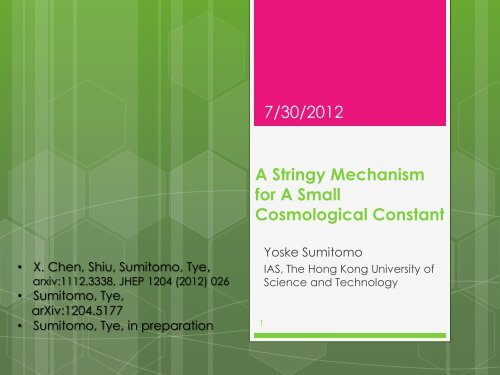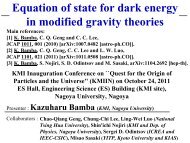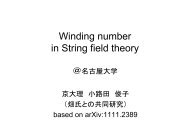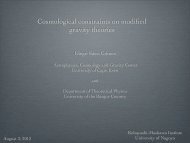A Stringy Mechanism for A Small Cosmological Constant
A Stringy Mechanism for A Small Cosmological Constant
A Stringy Mechanism for A Small Cosmological Constant
Create successful ePaper yourself
Turn your PDF publications into a flip-book with our unique Google optimized e-Paper software.
7/30/2012<br />
A <strong>Stringy</strong> <strong>Mechanism</strong><br />
<strong>for</strong> A <strong>Small</strong><br />
<strong>Cosmological</strong> <strong>Constant</strong><br />
• X. Chen, Shiu, Sumitomo, Tye,<br />
arxiv:1112.3338, JHEP 1204 (2012) 026<br />
• Sumitomo, Tye,<br />
arXiv:1204.5177<br />
• Sumitomo, Tye, in preparation<br />
1<br />
Yoske Sumitomo<br />
IAS, The Hong Kong University of<br />
Science and Technology
2<br />
7/30/2012<br />
Contents<br />
Motivation<br />
Moduli stabilization ~random approach~<br />
Moduli stabilization ~concrete models~<br />
Statistical approach<br />
More on product distribution<br />
Multi-moduli analyses<br />
Summary & Discussion
3<br />
7/30/2012<br />
Motivation
4<br />
Dark Energy<br />
Late time expansion<br />
Awarded Nobel Prize in 2011!<br />
What can be a source <strong>for</strong> this
5<br />
Acceleration<br />
The universe is accelerating if<br />
or pressure-density ratio:<br />
<strong>Cosmological</strong> scale<br />
EOM (Friedmann eq.)<br />
<strong>for</strong> flat background<br />
Observationally<br />
DE domination
Two possibilities<br />
6<br />
• For cosmological constant<br />
WMAP+BAO+SN suggests<br />
<strong>for</strong> a flat universe<br />
<strong>Cosmological</strong> constant<br />
• For time-varying DE<br />
WMAP+BAO+H0+DΔt+SN suggests<br />
Time varying DE<br />
e.g. <strong>Stringy</strong> Quintessence models<br />
[Kiwoon, 99], [Svrcek, 06], [Kaloper, Sorbo, 08],<br />
[Panda, YS, Trivedi, 10], [Cicoli, Pedro, Tasinato, 12]…
7<br />
7/30/2012<br />
dS<br />
Landscape<br />
dS<br />
Metastable vacua<br />
in moduli space<br />
• Inflation<br />
AdS<br />
rolling down<br />
(& tunneling)<br />
• dS vacua<br />
tunneling<br />
Low energy<br />
• AdS vacua<br />
We may stay here <strong>for</strong> a while.<br />
But how likely with tiny CC
8<br />
7/30/2012<br />
<strong>Stringy</strong> Landscape<br />
There are many types of vacua in string theory, as a result of<br />
a variety of (Calabi-Yau) compactification.<br />
ds 2 10 = ds 2 2<br />
4 + ds 6<br />
A class of Calabi-Yau gives Swiss-cheese type of volume.<br />
V 6 = γ 1 T 1 + T 1 − γ i T i + T i<br />
E.g. workable models:<br />
i=2<br />
,<br />
[Denef, Douglas, Florea, 04]<br />
4<br />
• P 1,1,1,6,9<br />
: h 1,1 = 2, h 2,1 = 272<br />
• F 11 : h 1,1 = 3, h 2,1 = 111<br />
• F 18 : h 1,1 = 5, h 2,1 = 89<br />
All can be stabilized<br />
(a la KKLT),<br />
but in various way.<br />
Any implication of multiple vacua
9<br />
7/30/2012<br />
Keys in this talk<br />
Product distribution<br />
Assuming products of random variables:<br />
z = y 1 y 2 y 3 ⋯<br />
Many terms<br />
Correlation<br />
through stabilization<br />
z = y 1 y 2 y 3 ⋯ f(y 1 , y 2 , y 3 , ⋯ )<br />
still peaked<br />
We apply this mechanism <strong>for</strong> cosmological constant (CC)
10<br />
7/30/2012<br />
Be<strong>for</strong>e proceeding…<br />
I have to say<br />
we don’t solve cosmological constant problem<br />
completely.<br />
But here,<br />
we introduce a tool to make cosmological<br />
constant smaller, maybe up to a certain value.<br />
“A <strong>Stringy</strong> <strong>Mechanism</strong> <strong>for</strong> A <strong>Small</strong> <strong>Cosmological</strong> <strong>Constant</strong>”
11<br />
7/30/2012<br />
Moduli stabilization<br />
~random approach~
12<br />
7/30/2012<br />
Gaussian suppression on stability<br />
Various vacua in string landscape<br />
Mass matrix given randomly at extrema<br />
How likely stable minima exist<br />
Positivity of mass matrix<br />
Positivity of Hessian<br />
∂ φi ∂ φj V<br />
min<br />
Real/complex symmetric matrix<br />
• Gaussian Orthogonal Emsemble<br />
[Aazami, Easther, 05], [Dean, Majumdar, 08], [Borot, Eynard, Majumdar, Nadal, 10]<br />
Z =<br />
dM ij e −1 2 tr M2 , M = M T<br />
Gaussian term dominates even at lower N.<br />
ln 3<br />
4<br />
∼ 0.275,<br />
ln 2 3−3<br />
2<br />
∼ −0.384
13<br />
7/30/2012<br />
Hierarchical setup<br />
• Assuming hierarchy between diag. and off-diag. comp.<br />
Actual models are likely to have minima at AdS.<br />
+ uplifting term toward dS vacua.<br />
Hessian = A + B where A: diagonal positive definite with σ A<br />
B: GOE with σ B<br />
Still Gaussianly suppressed, but a chance <strong>for</strong> dS<br />
P = a e −bN2 −cN<br />
[X. Chen, Shiu, YS, Tye, 11]<br />
When applying a model in type IIA,<br />
quite tiny chance remains.<br />
Larger<br />
hierarchy<br />
• Assuming more randomness in SUGRA at SUSY AdS<br />
P = e −bN2<br />
[Bachlechner, Marsh, McAllister, Wrase, 12]
14<br />
7/30/2012<br />
Moduli stabilization<br />
~concrete models~
15<br />
7/30/2012<br />
Type IIB<br />
Sources: H 3 , F 1 , F 3 , F 5 , dilaton, localized sources<br />
Metric: ds 2 10 = e 2A ds 2 4 + e −2A ds 6 2<br />
Calabi-Yau<br />
Then EOM becomes<br />
[Giddings, Kachru, Polchinski, 02]<br />
∇ 2 e 4A − α = e2A<br />
6 Im τ iG 3 −∗ 6 G 3 2 + e −6A ∂ e 4A − α 2 + (local sources)<br />
LHS=0 when integrating out<br />
positive contributions<br />
e 4A = α, iG 3 =∗ 6 G 3 : imaginary self-dual condition<br />
where α is a function in F 5 , G 3 = F 3 − τ H 3 , τ = C 0 + i e −φ
16<br />
7/30/2012<br />
No-scale structure<br />
Take a scaling: g mn → λ g mn<br />
e 4A = α, iG 3 =∗ 6 G 3 : invariant<br />
The other equations are also unchanged.<br />
No-scale structure<br />
superpotential W 0 = ∫ G 3 ∧ Ω is independent of Kahler<br />
4D effective potential with K = −3 ln T + T , W 0 = const<br />
V = e K M P 2 K IJ D I W 0 D J W 0 − 3 M P<br />
2 W 2 = 0<br />
Kahler directions remain flat.
17<br />
7/30/2012<br />
A bonus in type IIB<br />
Hierarchical structure of mass matrix/potential helps to<br />
stabilize moduli at positive cosmological constant.<br />
Moduli stabilization with positive cosmological constant<br />
• Fluxes Complex structure & dilaton<br />
[X. Chen, Shiu, YS, Tye, 12]<br />
• Non-perturbative effect, α ′ -correction, localized branes<br />
Kahler<br />
[KKLT, 03], [Balasubramanian, Berglund, Conlon, Quevedo, 05],<br />
[Balasubramanian, Berglund, 04]…<br />
V = V Flux + V NP + V α′ + ⋯<br />
No scale structure<br />
Complex<br />
Kahler<br />
Hierarchy<br />
between Kahler and Complex
18<br />
7/30/2012<br />
KKLT<br />
Non-trivial potential <strong>for</strong> Kahler is generated by NP-corrections.<br />
E.g.<br />
Gluino condensation on D7-branes<br />
D7-branes wrapping the four cycle: W NP = A e −a 8π2 g D7 = A e−a T<br />
Together with the superpotential from fluxes: W = W 0 + W NP<br />
Supersymmetric vacuum<br />
D T W = 0 existes.<br />
But exponentially small W 0 is<br />
required.<br />
|W 0 | ∼ A e −a T , naturally realized<br />
|W 0 | ∼ 10 −4
19<br />
7/30/2012<br />
Large Volume Scenario<br />
[Balasubramanian, Beglund, Conlon, Quevedo, 05]<br />
α ′ -corrections can break no-scale structure too.<br />
O α ′ 3 -correction in type II action [Becker, Becker, Haack, Louis, 02]<br />
K = −2 ln V + ξ 2 −i τ + τ 3 2<br />
− ln(−i τ + τ ) + ⋯<br />
4<br />
E.g. P 1,1,1,6,9<br />
scales differently<br />
model (assuming complex sector is stabilized)<br />
V = 1<br />
9 2 t 3 2 3<br />
1 − t 2 2 , W = W 0 + A 1 e −a 1T 1 + A 2 e −a 2T 2<br />
Solution: W 0 ∼ −20, A 1 ∼ 1, t 1 ∼ 10 6 , t 2 ∼ 3<br />
V min ∼ −10 −25 : AdS vacua<br />
|W 0 | ≫ |W NP |, V ≫ ξ: naturally realized
20<br />
7/30/2012<br />
Kahler uplifting<br />
Same setup as that of LVS<br />
[Balasubramanian, Berglund, 04],<br />
[Westphal, 06], [Rummel, Westphal, 11],<br />
[de Alwis, Givens, 11]<br />
K = −2 ln V + ξ 2 + ⋯ , V = γ 1 T 1 + T 1 − γ i T i + T i<br />
,<br />
i=2<br />
W = W 0 + A 1 e −a 1T 1 +<br />
A i e −a iT i<br />
i=2<br />
Interested in a region<br />
where this term plays a roll.<br />
less large volume than LVS, but still |W 0 | ≫ |W NP |, V ≫ ξ<br />
E.g. single modulus<br />
[Rummel, Westphal, 11]<br />
V ∼ − W 0a 1 3 A 1<br />
2 γ 1<br />
2<br />
2C<br />
9x 1<br />
9 2 − e−x 1<br />
x 1<br />
2<br />
, C = −27 W 0 ξ a 1<br />
3 2<br />
64 2γ 1 A 1<br />
, x 1 = a 1 t 1<br />
When W 0 A 1 < 0, the C ∝ ξ term contributes the uplifting.
21<br />
7/30/2012<br />
KKLT vs Kahler uplifting<br />
• KKLT<br />
Add an uplifting potential by hand<br />
V = V SUGRA + V D3−D3<br />
V D3−D3 = 2T 3 d 4 x −g 4<br />
Backreaction of D3<br />
Safe or not<br />
• Kahler uplifting<br />
V = V SUGRA<br />
A singularity exists, but finite action<br />
[DeWolfe, Kachru, Mulligan, 08], [McGuirk, Shiu, YS, 09],<br />
[Bena, Giecold, Grana, Halmagyi, Massai, 09-12], [Dymarsky, 11],…<br />
Owing to |W 0 | ≫ |W NP |<br />
SUGRA + α′-correction<br />
No fine-tuning <strong>for</strong> W 0
22<br />
7/30/2012<br />
Statistical approach
23<br />
7/30/2012<br />
Further approximation<br />
V<br />
4<br />
M = − W 0a 3 1 A 1 C<br />
P<br />
2 γ 1 9x<br />
9 2 − e−x 1<br />
2<br />
, C = −27W 3<br />
0ξa 1<br />
2<br />
1 x 1 64 2γ 2 , x 1 = a 1 t 1<br />
1 A 1<br />
Further focusing on smaller CC region: C ∼ 3.65<br />
[Rummel, Westphal, 11]<br />
The stability constraint with positive CC at stationery points:<br />
V ≥ 0 3.65 ≤ C < 3.89<br />
∂ 2 x V > 0<br />
V<br />
M P<br />
4 ∼ 1 9<br />
2<br />
5<br />
9<br />
2 −W 0 a 1 3 A 1<br />
γ 1<br />
2<br />
C − 3.65<br />
Neglecting the parameters a 1 , γ 1 , ξ, the model is simplified to be<br />
Λ = w 1 w 2 c − c 0 , c 0 ≤ c = w 1<br />
w 2<br />
< c 1<br />
(w 1 = −W 0 , w 2 = A 1 , c ∝ C)
24<br />
7/30/2012<br />
<strong>Stringy</strong> Random Landscape<br />
Starting with the simplified potential:<br />
[YS, Tye, 12]<br />
Λ = w 1 w 2 c − c 0 , c 0 ≤ c = w 1<br />
w 2<br />
< c 1<br />
Since W 0 , A 1 are given model by model (various ways of<br />
stabilizing complex moduli), here we impose reasonable<br />
randomness on parameters.<br />
w 1 , w 2 ∈ [0, 1], uni<strong>for</strong>m distribution (<strong>for</strong> simplicity)<br />
Probability distribution function<br />
P Λ = N 0 dc dw 1 dw 2 δ w 1 w 2 c − c 0 − Λ δ w 1<br />
w 2<br />
− c<br />
N 0 : normalization constant
25<br />
7/30/2012<br />
Divergence in product distribution<br />
When z = w 1 w 2 ,<br />
P z = dw 1 dw 2 δ w 1 w 2 − z = 1 2 ln 1 z<br />
log divergence at z = 0<br />
With constraint Λ = w 1 w 2 c − c 0 , c 0 ≤ c = w 1<br />
< c<br />
w 1<br />
2<br />
P Λ = c 1<br />
ln c positivity stability<br />
1 − c 0<br />
c 1 − c 0 c 1 Λ still diverging!!<br />
Comparison to the full-potential (randomizing W 0 , A 1 without approx.)<br />
Good agreement<br />
at smaller Λ
26<br />
7/30/2012<br />
Zero-ness of parameters<br />
We assumed the parameters W 0 , A 1 passing through zero value,<br />
but is it true<br />
• E.g. T 6 model: W 0 = c 1 + d i U i − c 2 + e i U i S<br />
SUSY condition<br />
W 0 = 2 c 1 + c 2 s<br />
easy to be zero<br />
i<br />
k<br />
d i + e i s<br />
d k − e k s<br />
(d j − e j s)<br />
j≠i<br />
s = Re(S)<br />
• Brane position dependence of A 1<br />
[Baumann, Dymarsky, Klebanov,<br />
Maldacena, McAllister, Murugan, 06]<br />
A 1 = A 1 U i f X i<br />
1/n<br />
, f Xi = X i<br />
p i<br />
− μ q<br />
f X i<br />
= 0 when D3-brane hits D7-brane (divisor, at μ)<br />
known as Ganor zero
31<br />
7/30/2012<br />
Comments on sum distribution<br />
Sum distribution smooths out the divergence and moves the peak.<br />
E.g. z = x 1<br />
n 1<br />
+ x 2<br />
n 2<br />
+ ⋯ + x p<br />
n p<br />
• Each has divergent peak: P w i = x i<br />
n i ∝ wi<br />
−1+ 1 n i<br />
• Independent of each other, no correlations.<br />
But uncorrelated summation gives P z ∝ z −1+ 1<br />
n i .<br />
When all n i = 2, and x i ∈ normal distribution,<br />
P z = e−p 2 z −1+p 2<br />
2 p 2 Γ(p 2)<br />
p = 1<br />
p =2<br />
known as Chi-squared distribution<br />
p =3
32<br />
7/30/2012<br />
Bousso-Polchinski<br />
4-<strong>for</strong>m quantization<br />
S = d 4 x −g 1 M P<br />
2 R − Λ bare − Z<br />
2 × 4! F 4 2<br />
Λ = Λ bare + 1 2<br />
n i 2 q i<br />
2<br />
Assume randomness in Bousso-Polchinski;<br />
J<br />
n i : random integer, 0 ≤ q i ≤ 1: uni<strong>for</strong>m,<br />
−100 ≤ Λ bare ≤ 0: uni<strong>for</strong>m<br />
Λ = 0<br />
But…<br />
Moduli fields couple each term<br />
Λ ∼ −W 0 A 1<br />
C<br />
9x<br />
9 2 − e−x 1<br />
2<br />
1 x 1<br />
correlation generated via stabilization
33<br />
7/30/2012<br />
Multi-moduli analyses
34<br />
7/30/2012<br />
Multi-moduli stabilization<br />
Again, we work in the region: |W 0 | ≫ |W NP |, V ≫ ξ.<br />
Assuming stabilization of complex structure moduli and dilaton<br />
at higher energy scale,<br />
V<br />
4<br />
M = − A 3<br />
1W 0 a 1 2C<br />
P<br />
2 γ 1 9V 3 − x 1e −x 1<br />
V 2<br />
3<br />
V = x 2 3 2<br />
1 − δ i x i<br />
,<br />
i=2<br />
−<br />
i=2<br />
• Now we have N K × N K mass matrix.<br />
B i x i e −x i<br />
V 2<br />
• Stability at positive CC requires B i > 0.<br />
x i = a i t i , C = −27W 3 2<br />
0ξa 1<br />
, B i = A i<br />
, δ<br />
64 2γ 1 A 1<br />
A i = γ 3 2<br />
ia i<br />
3 2<br />
1 γ 1 a 1<br />
N K extremal equations + N K stability constraints<br />
Uplifting is controlled by the first term.<br />
[Sumitomo, Tye, in preparation]<br />
All upper-left sub-determinants are positive (Sylvester’s criteria).<br />
,
37<br />
7/30/2012<br />
Multi-Kahler statistics<br />
Still complicated system<br />
V<br />
4<br />
M = − A 3<br />
1W 0 a 1 2C<br />
P<br />
2 γ 1 9V 3 − x 1e −x 1<br />
V 2 −<br />
i=2<br />
B i x i e −x i<br />
We just randomize W 0 , A i obeying uni<strong>for</strong>m distribution,<br />
while keeping other parameters fixed.<br />
Solve <strong>for</strong> t i (or x i ) −15 ≤ W 0 ≤ 0, 0 ≤ A i ≤ 1<br />
V 2<br />
N K = 1: blue<br />
N K = 3: red<br />
(neglecting N K =1)<br />
More moduli bring shaper peak.<br />
(though mild suppression)<br />
Λ ∼ 1.1 × 10 −3 N K 0.23 e −0.027 N KM P<br />
4
38<br />
7/30/2012<br />
<strong>Cosmological</strong> moduli problem<br />
Reheating <strong>for</strong> BBN: T r ≥ O 10 MeV T r ∼ M P Γ φ , Γ φ ∼ m φ 3<br />
m φ ≥ O 10 TeV ∼ 10 −15 M P<br />
What happens in lightest (physical) moduli mass<br />
M P<br />
(neglecting N K =1)<br />
2<br />
m min<br />
= 0.031 N K 1.0 e −0.10 N KM P<br />
2<br />
: also suppressed<br />
Suppression of mass is relatively faster than Λ.<br />
2<br />
m min<br />
∼ 10 −30 M P<br />
2<br />
is likely met earlier than Λ ∼ 10 −122 M P<br />
4
39<br />
7/30/2012<br />
More peaked parameters<br />
So far we assumed uni<strong>for</strong>m distribution <strong>for</strong> W 0 , A i . But realistic<br />
models have a number of complex moduli and others.<br />
Different distributions <strong>for</strong> W 0 , A i<br />
Consider the effect of multiple independent parameters.<br />
W 0 = −w 1 w 2 ⋯ w n ,<br />
A i = y 1 i y 2<br />
i<br />
⋯ y n<br />
i<br />
0 ≤ w i ≤ 15 1 n , 0 ≤ yj<br />
i<br />
≤ 1, all obey uni<strong>for</strong>m distribution.<br />
Now,<br />
P W0 =<br />
P A i =<br />
1<br />
15 n − 1 !<br />
1<br />
n − 1 !<br />
ln 15<br />
ln 1 A i<br />
W 0<br />
n−1<br />
n−1<br />
,<br />
n=3<br />
n=2<br />
n=1<br />
See how CC is affected by “n”
40<br />
7/30/2012<br />
<strong>Cosmological</strong> constant<br />
We cannot simply consider effect of the coefficient.<br />
V<br />
4<br />
M = − A 3<br />
1W 0 a 1 2C<br />
P<br />
2 γ 1 9V 3 − x 1e −x 1<br />
V 2<br />
−<br />
i=2<br />
B i x i e −x i<br />
V 2<br />
Dynamics also affects.<br />
The result:<br />
Λ NK =1 = 4.7 × 10 −3 n 0.080 e−1.40 n<br />
Red: N K = 1<br />
Blue: N K = 2<br />
Green: N K = 3<br />
Λ NK =2 = 3.7 × 10 −3 n 0.97 e−1.49 n<br />
Λ NK =3 = 3.4 × 10 −3 n 1.5 e−1.55 n<br />
More than the effect of<br />
the coefficient!<br />
A 1 W 0<br />
∼ 15 e−1.39 n
41<br />
7/30/2012<br />
Moduli mass<br />
We worry about the cosmological moduli problem.<br />
Red: N K = 1<br />
Blue: N K = 2<br />
Green: N K = 3<br />
2<br />
m min<br />
2<br />
m min<br />
2<br />
m min<br />
= 0.18 N K =1 n0.14 −1.40 n<br />
e<br />
= 0.061 N K =2 n0.73 −1.56 n<br />
e<br />
= 0.039 N K =3 n1.2 −1.66 n<br />
e<br />
Compare with CC<br />
Λ ∝ e −1.40 n , e −1.49 n , e−1.55 n<br />
Suppression in mass is getting<br />
larger as increasing N K .<br />
also suggests
42<br />
7/30/2012<br />
Estimation<br />
Using the estimated functions, we get<br />
N K (= h 1,1 ) 1 2 3<br />
Λ ∼ 10 −122 4<br />
M P n ∼ 197 n ∼ 188 n ∼ 182<br />
m 2 ∼ 10 −30 2<br />
M P n ∼ 48 n ∼ 44 n ∼ 42<br />
n: number of<br />
product in W 0 , A i<br />
Rather considerable number, e.g.<br />
4<br />
• P 1,1,1,6,9<br />
: h 1,1 = 2, h 2,1 = 272<br />
• F 11 : h 1,1 = 3, h 2,1 = 111<br />
and the other moduli (e.g. brane position, open string) come<br />
in a complicated way, like<br />
• A 1 = A 1 U i f X i<br />
1/n<br />
, f Xi = X i<br />
p i<br />
− μ q<br />
While, without help of product distribution in W 0 , A i<br />
N K ∼ 10100 <strong>for</strong> Λ ∼ 10 −122 M P 4 , N K ∼ 1350 <strong>for</strong> m 2 ∼ 10 −30 M P<br />
2
43<br />
7/30/2012<br />
Mass matrix<br />
Physical mass matrix is a linear combination of ∂ xi ∂ xj V| min .<br />
Assuming uni<strong>for</strong>mly distributed −15 ≤ W 0 ≤ 0, 0 ≤ A i ≤ 1,<br />
∂ xi ∂ xj V min<br />
∼ 10 −3 ×<br />
x 1 x 2 ⋯ x NK<br />
7 4 ⋯ ⋯ 4<br />
4 60 1 ⋯ 1<br />
⋮ 1 ⋱ ⋯ ⋮<br />
⋮ ⋮ ⋮ ⋱ 1<br />
4 1 ⋯ 1 60<br />
some<br />
hierarchical<br />
structures<br />
Though off-diagonal comp. are relatively suppressed,<br />
eigenvalue repulsion gets more serious when increasing N K .<br />
e.g. 2 × 2 matrix: a<br />
b<br />
b<br />
c<br />
λ ± = 1 2 a + c ± a − c 2 + 4b 2<br />
The lowest mass eigenvalue is generically suppressed<br />
more than CC.
44<br />
7/30/2012<br />
Summary & Discussion
45<br />
7/30/2012<br />
Summary & Discussion<br />
• <strong>Stringy</strong> Random Landscape<br />
We may expect that stringy motivated models have the<br />
following properties:<br />
• Product of parameters<br />
• Correlation of each term by dynamics<br />
Both works <strong>for</strong> smaller CC.<br />
• A number of Kahler moduli<br />
Correlation makes CC smaller. But the effect is modest.<br />
• A number of complex moduli and other moduli<br />
Those are likely to produce more peakiness in parameters<br />
Interesting to see detailed effect in concrete models
46<br />
7/30/2012<br />
Summary & Discussion<br />
• A potential problem<br />
Lightest moduli mass is suppressed simultaneously.<br />
cosmological moduli problem<br />
be<strong>for</strong>e reaching Λ ∼ 10 −122 M P 4 .<br />
Other than “product” and “correlation” effect,<br />
“eigenvalue repulsion” also makes the value smaller.<br />
This is presumably a generic problem<br />
when taking statistical approach without fine-tuning.<br />
Once finding a way out, the stringy mechanism<br />
naturally explain why CC is so small.<br />
Thermal inflation, coupling suppression to SM,<br />
or some other corrections may help










